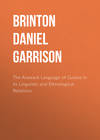Czytaj książkę: «The Arawack Language of Guiana in its Linguistic and Ethnological Relations»
THE ARAWACK LANGUAGE OF GUIANA IN ITS LINGUISTIC AND ETHNOLOGICAL RELATIONS.
BY D. G. BRINTON, M. D
The Arawacks are a tribe of Indians who at present dwell in British and Dutch Guiana, between the Corentyn and Pomeroon rivers. They call themselves simply lukkunu, men, and only their neighbors apply to them the contemptuous name aruac (corrupted by Europeans into Aroaquis, Arawaaks, Aroacos, Arawacks, etc.), meal-eaters, from their peaceful habit of gaining an important article of diet from the amylaceous pith of the Mauritia flexuosa palm, and the edible root of the cassava plant.
They number only about two thousand souls, and may seem to claim no more attention at the hands of the ethnologist than any other obscure Indian tribe. But if it can be shown that in former centuries they occupied the whole of the West Indian archipelago to within a few miles of the shore of the northern continent, then on the question whether their affiliations are with the tribes of the northern or southern mainland, depends our opinion of the course of migration of the primitive inhabitants of the western world. And if this is the tribe whose charming simplicity Columbus and Peter Martyr described in such poetic language, then the historian will acknowledge a desire to acquaint himself more closely with its past and its present. It is my intention to show that such was their former geographical position.
While in general features there is nothing to distinguish them from the red race elsewhere, they have strong national traits. Physically they are rather undersized, averaging not over five feet four inches in height, but strong-limbed, agile, and symmetrical. Their foreheads are low, their noses more allied to the Aryan types than usual with their race, and their skulls of that form defined by craniologists as orthognathic brachycephalic.
From the earliest times they have borne an excellent character. Hospitable, peace-loving, quick to accept the humbler arts of civilization and the simpler precepts of Christianity, they have ever offered a strong contrast to their neighbors, the cruel and warlike Caribs. They are not at all prone to steal, lie, or drink, and their worst faults are an addiction to blood-revenge, and a superstitious veneration for their priests.
They are divided into a number of families, over fifty in all, the genealogies of which are carefully kept in the female line, and the members of any one of which are forbidden to intermarry. In this singular institution they resemble many other native tribes.
LANGUAGE
The earliest specimen of their language under its present name is given by Johannes de Laet in his Novus Orbis, seu Descriptio Indiæ Occidentalis (Lugd. Bat. 1633). It was obtained in 1598. In 1738 the Moravian brethren founded several missionary stations in the country, but owing to various misfortunes, the last of their posts was given up in 1808. To them we owe the only valuable monuments of the language in existence.
Their first instructor was a mulatto boy, who assisted them in translating into the Arawack a life of Christ. I cannot learn that this is extant. Between 1748 and 1755 one of the missionaries, Theophilus Schumann, composed a dictionary, Deutsch-Arawakisches Wœrterbuch, and a grammar, Deutsch-Arawakische Sprachlehre, which have remained in manuscript in the library of the Moravian community at Paramaribo. Schumann died in 1760, and as he was the first to compose such works, the manuscript dictionary in the possession of Bishop Wullschlägel, erroneously referred by the late Professor von Martius to the first decade of the last century, is no doubt a copy of Schumann’s.
In 1807 another missionary, C. Quandt, published a Nachricht von Surinam, the appendix to which contains the best published grammatical notice of the tongue. The author resided in Surinam from 1769 to 1780.
Unquestionably, however, the most complete and accurate information in existence concerning both the verbal wealth and grammatical structure of the language, is contained in the manuscripts of the Rev. Theodore Schultz, now in the library of the American Philosophical Society. Mr. Shultz was a Moravian missionary, who was stationed among the Arawacks from 1790 to 1802, or thereabout. The manuscripts referred to are a dictionary and a grammar. The former is a quarto volume of 622 pages. The first 535 pages comprise an Arawack-German lexicon, the remainder is an appendix containing the names of trees, stars, birds, insects, grasses, minerals, places, and tribes. The grammar, Grammattikalische Sätze von der Aruwakkischen Sprache, is a 12mo volume of 173 pages, left in an unfinished condition. Besides these he left at his death a translation of the Acts of the Apostles, which was published in 1850 by the American Bible Society under the title Act Apostelnu. It is from these hitherto unused sources that I design to illustrate the character of the language, and study its former extension.1
PHONETICS
The Arawack is described as “the softest of all the Indian tongues.”2 It is rich in vowels, and free from gutturals. The enunciation is distinct and melodious. As it has been reduced to writing by Germans, the German value must be given to the letters employed, a fact which must always be borne in mind in comparing it with the neighboring tongues, nearly all of which are written with the Spanish orthography.
The Arawack alphabet has twenty letters: a, b, d, e, g, h, i, j, k, l, m, n, o, p, q, r, s, t, u, w.
Besides these, they have a semi-vowel written lr the sound of which in words of the masculine gender approaches l, in those of the neuter gender r. The o and u, and the t and d, are also frequently blended. The w has not the German but the soft English sound, as in we. The German dipthongs æ, œ, eu, ei, ü, are employed. The accents are the long ^, the acute `, and that indicating the emphasis ´. The latter is usually placed near the commencement of the word, and must be carefully observed.
NOUNS
Like most Indians, the Arawack rarely uses a noun in the abstract. An object in his mind is always connected with some person or thing, and this connection is signified by an affix, a suffix, or some change in the original form of the word. To this rule there are some exceptions, as bahü a house, siba a stone, hiäru a woman. Dáddikân hiäru, I see a woman. Such nouns are usually roots. Those derived from verbal roots are still more rarely employed independently.
Numbers. The plural has no regular termination. Often the same form serves for both numbers, as is the case in many English words. Thus, itime fish and fishes, siba stone and stones, känsiti a lover and lovers. The most common plural endings are ati, uti, and anu, connected to the root by a euphonic letter; as uju mother, ujunuti mothers, itti father, ittinati fathers, kansissia a loved one, kansissiannu loved ones.
Of a dual there is no trace, nor does there seem to be of what is called the American plural (exclusive or inclusive of those present). But there is a peculiar plural form with a singular signification in the language, which is worthy of note. An example will illustrate it; itti is father, plural ittinati; wattinati is our father, not our fathers, as the form would seem to signify. In other words, singular nouns used with plural pronouns, or construed with several other nouns, take a plural form. Petrus Johannes mutti ujúnatu, the mother of Peter and John.
Genders. A peculiarity, which the Arawack shares with the Iroquois3 and other aboriginal languages of the Western continent, is that it only has two genders, and these not the masculine and feminine, as in French, but the masculine and neuter. Man or nothing was the motto of these barbarians. Regarded as an index of their mental and social condition, this is an ominous fact. It hints how utterly destitute they are of those high, chivalric feelings, which with us centre around woman.
The termination of the masculine is i, of the neuter u, and, as I have already observed, a permutation of the semi-vowels l and r takes place, the letter becoming l in the masculine, r in the neuter. A slight difference in many words is noticeable when pronounced by women or by men. The former would say keretin, to marry; the latter kerejun. The gender also appears by more than one of these changes: ipillin, great, strong, masculine; ipirrun, feminine and neuter.
There is no article, either definite or indefinite, and no declension of nouns.
PRONOUNS
The demonstrative and possessive personal pronouns are alike in form, and, as in other American languages, are intimately incorporated with the words with which they are construed. A single letter is the root of each: d I, mine, b thou, thine, l he, his, t she, her, it, its, w we, our, h you, your, n they, their; to these radical letters the indefinite pronoun ükküahü, somebody, is added, and by abbreviation the following forms are obtained, which are those usually current:
dakia, dai, I.
bokkia, bui, thou.
likia, he.
turreha, she, it.
wakia, wai, we.
hukia, hui, you.
nakia, nai, they.
Except the third person, singular, they are of both genders. In speaking, the abbreviated form is used, except where for emphasis the longer is chosen.
In composition they usually retain their first vowel, but this is entirely a question of euphony. The methods of their employment with nouns will be seen in the following examples:
üssiquahü, a house.
dássiqua, my house.
bússiqua, thy house.
lüssiqua, his house.
tüssiqua, her, its house.
wássiqua, our house.
hüssiqua, your house.
nássiqua, their house.
uju, mother.
daiju, my mother.
buju, thy mother.
luju, his mother.
tuju, her mother.
waijunattu, our mother.
hujuattu, your mother.
naijattu, their mother.
waijunuti, our mothers.
hujunuti, your mothers.
naijunuti, their mothers.
Many of these forms suffer elision in speaking. Itti father, datti my father, wattínatti our father, contracted to wattínti (watti rarely used).
When thus construed with pronouns, most nouns undergo some change of form, usually by adding an affix; báru an axe, dábarun my axe, iulí tobacco, dajulite my tobacco.










